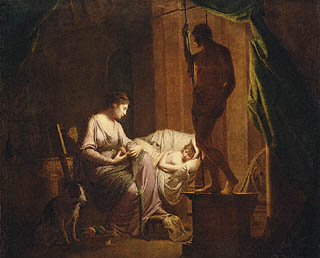• How many people are depicted in this work of art? What might their relationship be to one another?
(Two people: Penelope, wife of Odysseus, and her son
Telemachus are present. A statue of a third person,
Odysseus, is in the
scene and represents this absent husband and father.)
• At what time of day does this scene take place? How can you tell? Where does the light source used in
this image seem to be coming from? (Nighttime. The dark environment and sleeping child suggest night.
According to the story, at night Penelope unwound the shroud she was working on to keep her suitors at bay.
The light source seems to be a candle or oil lamp at the base of the statue.)
• How would you describe the mood of this scene? How does Wright of Derby use the postures of the figures
and color to create the mood? The mood is somber and quiet. Wright of Derby uses muted colors and warm
candlelight to illuminate Penelope and Telemachus, yet leaves the statue of Odysseus as a silhouette.
The rigid postures of the figures add to the somber mood.)
• How does the treatment of light and shadow inform the story? (The shaded statue of Odysseus suggests
his absence, while the light cast on Penelope and Telemachus exposes their vulnerability and humanity.)
• One of the goals of Neoclassical painting was to depict a virtuous life that emphasized loyalty and productivity.
How does this painting reflect these qualities? (Virtue and loyalty are embodied by the devotion of Penelope, who,
rather than betray her husband, cooks up the ruse to keep her suitors at bay. The dog, Argos, is also a representation
of loyalty, as he awaits his master's return. Productivity is suggested by the weaving.)
• Who do you relate to most in this work of art? |
This intimate scene is based on Alexander Pope's 1772 translation of
Homer's Odyssey. Penelope, awaiting the return of
her husband Odysseus from the Trojan War, was beset by suitors who claimed that Odysseus had been shipwrecked. She promised
to marry one of them after she completed a death shroud for her father-in-law. Steadfastly loyal to her absent husband,
Penelope unraveled her weaving at the end of each day to avoid remarrying. Joseph Wright of Derby depicted her late at night,
rewinding her thread into a ball.
The artist adds several details of his own to enhance the story and to show off his skill: the statue of Odysseus, the sleeping
Telemachus, and the dog Argos, an emblem of fidelity. In the foreground, the silhouetted statue of Odysseus invokes his presence.
Wright of Derby was working during the heyday of shadow portraits, or silhouettes, a popular form of portrait made by tracing the
sitter's shadow in black paint or cut black paper. These inexpensive artworks were commissioned and purchased by all levels of
society, and the silhouette of Odysseus would have resonated with the contemporary viewer. Candlelight bathes the sleeping figure
of Telemachus, while Penelope looks on compassionately. Wright of Derby greatly demonstrates his ability to model figures with
light and shadow through the inclusion of these elements. The strong effect of light and dark contributes to the hushed atmosphere
and increases the drama of Penelope's plight.
As a tribute to female loyalty and industry, the potter Josiah Wedgwood commissioned this painting, along with a companion piece
entitled the Corinthian Maid, which depicts the ancient myth of the Invention of Drawing. At this time, weaving was the
second-fastest-growing business of the early Industrial Revolution, and the choice of this subject reflected both the moral
character and shrewd business sense of the patron.
About the Artist
Joseph Wright of Derby, 1734–1797
English
The effects of light fascinated Joseph Wright of Derby. An attorney's son born in 1734, he trained as a portrait painter in
London, but he returned to Derby, the first major English painter to build his career outside the capital. His meticulously
painted figure groups in dark interiors illuminated by candles or lamps carried his reputation to London. The dramatic contrasts
of light and shade in his work showed the influence of 17th-century Dutch painters like Gerrit van Honthorst (1590–1656)
and Rembrandt van Rijn (1606–1669), but Wright of Derby was an innovator, inventing the scientific Enlightenment subject: scenes of experiments, new machinery, and portraits of the leaders of the Industrial Revolution.
In 1773 Wright of Derby went to Italy. Vesuvius's volcanic eruption and Rome's annual fireworks display impressed him, and he
began to understand how his interest in light sources could be combined with landscape painting. Returning to Derby in 1777,
he found a steady stream of portrait clients who he satisfied with more penetrating characterizations, more complex iconography (traditional symbols associated with a subject), more subdued coloring, and, frequently, literary themes. With the leisure to choose subjects, he increasingly painted landscapes,
seeking truthful observation of nature, including rock formations or effects of light and atmosphere, without sacrificing aesthetic
values like poetry, beauty, drama, and composition.
|
